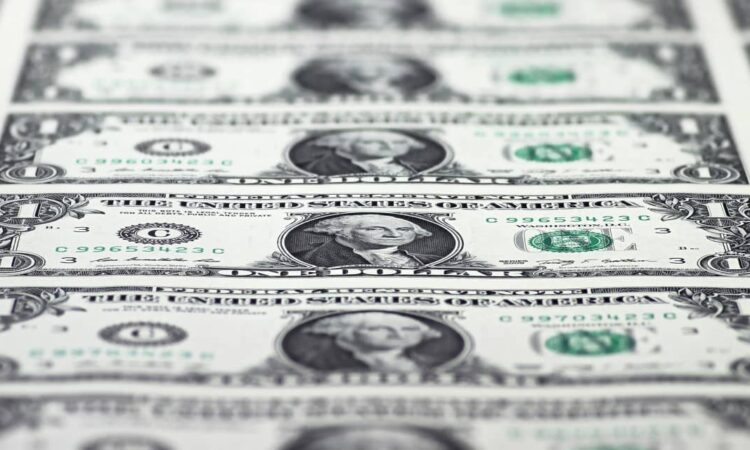
This commentary was issued recently by money managers, research firms, and market newsletter writers and has been edited by Barron’s.
Global Focus: Economics
NDR Ned Davis Research
Aug. 17: Rising U.S. fiscal debt and political dysfunction have enticed many to say that the dollar will quickly lose its status as the world’s reserve and most actively traded currency. But there is not enough evidence to suggest that the dollar will lose its status in the near term.
Based on foreign-exchange turnover data from the Bank for International Settlements’ Triennial survey, one can see that in 2022, the U.S. dollar was involved in almost every single foreign-exchange transaction. In far second place is the euro, followed by the yen. The dollar’s share has been little-changed over the past decades. Chinese yuan transactions have increased at the expense of other currencies, but to a still very small 7%.
Despite the U.S.’s high public debt, once one considers the nation’s economic size, growth prospects, and global status, there is no good alternative to the dollar.
Changes in reserve status also take time. In the 19th century, the British economy was the world’s largest, with the pound being the world’s major currency. The U.S. economy’s size surpassed Britain’s in 1916. But it wasn’t until after WW II that the dollar became the world’s major currency.
Advertisement – Scroll to Continue
Alejandra Grindal
AI and the Economy
Special Commentary
Wells Fargo
Aug. 17: Much of the conversation surrounding generative artificial intelligence has focused on its potential impact on the labor market. But there is an important impact on productivity growth that is often overlooked in the commentary on AI. Generative AI has the potential to raise productivity growth and thereby growth in real per capita income.
Another byproduct of stronger productivity growth is a rise in real interest rates. If, as we surmise, the productivity-enhancing effects of AI lead to stronger potential economic growth, then nominal interest rates could be higher in coming years than they were during the decade of the 2010s.
Advertisement – Scroll to Continue
Jay H. Bryson and team
6% Yields Ahead?
US Watch – Quick Insights
TS Lombard
Aug. 16: The Federal Reserve will ease when the unemployment rate broaches 4% and not before. Recessionary dynamics are in place, now aided by capital market price shifts, and this keeps my recession call in place. The risk of reacceleration as the slowdown from 2021 bottoms, that, in time, delivers an upward bias to inflation, is not a probability to be ignored.
If there is no recession by autumn, a 6.5% federal-funds rate and a 6% 10-year U.S. Treasury yield wouldn’t be a surprise. But everything working out as the Fed lays out would be.
Advertisement – Scroll to Continue
Steven Blitz
Mind the Gold/Silver Ratio
Daily Insights
BCA Research
Aug. 16: The gold/silver ratio, or GSR, entered a well-defined tapered wedge formation with downside support near 80, and an upside breakout around the 90 level.
Back in 2020, this ratio was caught up in a race toward major overhead resistance at 100, but finally hit a three-decade high of 93.3. In hindsight, the history of these reversals is that they tend to be powerful, quick, and extremely volatile. This not only suggests that an excellent entry point to short gold versus silver is on the horizon but also provides important information on the battleground between economic growth and tighter financial conditions. A lower GSR will suggest that growth is winning this tug of war.
Gold and silver both benefit from falling yields and a weaker dollar, but silver’s response to any nascent improvement in growth tends to be explosive. There are a few reasons for this. Silver gains from higher industrial use and demand from the green-energy revolution (a substantial portion of silver demand goes into solar panels and electronics). Meanwhile, there has been a severe deficit in silver mining over the past few years.
Roukaya Ibrahim and team
Advertisement – Scroll to Continue
Japan’s Export Engine
Market Commentary
Navellier & Associates
Aug. 15: Japan has been a beneficiary of China’s woes and reported on Tuesday that its gross domestic product surged 1.5% (6% annual pace) in the second quarter. Japanese exports rose 3.2% in the second quarter compared with the first quarter. As an example,
Subaru
’s
global car sales rose 20% in the second quarter. Although global export demand remains strong, Japan’s two largest trading partners, namely China and the U.S., are importing less from Japan.
Advertisement – Scroll to Continue
The real key to Japan’s export boom is emerging market economies, which bodes well for worldwide GDP growth. Since Japan is an aging society, its domestic demand remains weak, and private consumption declined 0.5% in the second quarter. Also notable is that Japan’s imports declined 4.3% in the second quarter compared with the first. Japan is the third largest economy in the world.
Louis Navellier
Consumers’ Challenge
Economic Update
Regions Financial
Aug. 15: Total retail sales rose by 0.7 percent in July, better than what we and the consensus expected, with ex-auto sales up 1.0% and control retail sales up 1.0%, topping our above-consensus forecast of a 0.7% increase….
That third-quarter growth in consumer spending got off to a faster start than we had anticipated doesn’t really alter our view of what comes next. We have for some time anticipated a marked weakening in discretionary services spending come the end of summer, as is still the case. At the same time, higher food and energy prices will pose additional hurdles for consumers, who thus far have proved to be notably resilient.
Richard F. Moody
To be considered for this section, material, with the author’s name and address, should be sent to [email protected].




